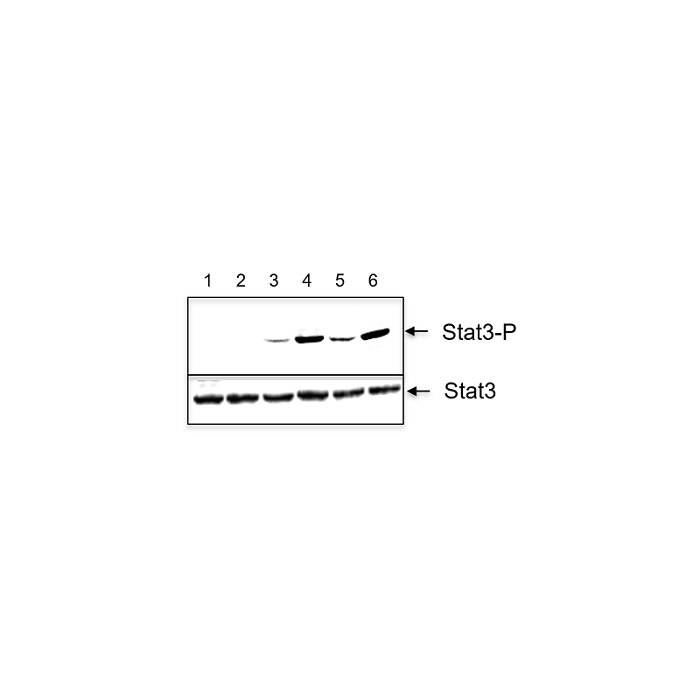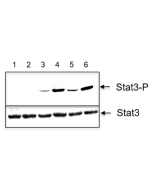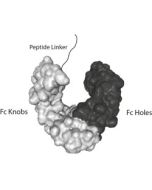Cookie Policy: This site uses cookies to improve your experience. You can find out more about our use of cookies in our Privacy Policy. By continuing to browse this site you agree to our use of cookies.
AdipoGen Life Sciences
IL-22 (mouse):Fc (mouse) (rec.) (non-lytic)

Method: 2x105 HT-29 cells (a human colorectal adenocarcinoma cell line) are treated with 1) control protein (10nM); 2) Control protein (100nM; 3) IL-22 (mouse):Fc (mouse) (rec.) (non-lytic) (Prod. No. AG-40B-0231) (10nM); 4) IL-22 (mouse):Fc (mouse) (rec.) (non-lytic) (Prod. No. AG-40B-0231) (100nM); 5) IL-22 (human):Fc (human) (rec.) (non-lytic) (Prod. No. AG-40B-0230) (10nM) 6) IL-22 (human):Fc (human) (rec.) (non-lytic) (Prod. No. AG-40B-0230) (100nM) for 30 minutes. Cells are lysed and cell extracts are separated by SDS-PAGE (12.5%) under reducing conditions, transferred to nitrocellulose overnight and incubated with anti-Phospho-Stat3 (Tyr705) (human), Rabbit Monoclonal (RM261) (Prod. No. REV-31-1142-00) (1/1000) or anti-Stat3, Rabbit Monoclonal (RM465) (Prod. No. REV-31-1357-00) (1/1’000). After addition of an anti-rabbit secondary antibody coupled to HRP (1/5’000), proteins are visualized by a chemiluminescence detection system.
Method: 4x104 COLO 205 cells (a human colorectal adenocarcinoma cells) are treated in 96 wells plate with 1) control protein (100 pM); 2) IL-22 (human):Fc (human) (rec.) (non-lytic) (Prod. No. AG-40B-0230) (100 pM); 3) IL-22 (mouse): Fc (mouse) (rec.) (non-lytic) (Prod. No. AG-40B-0231) (100 pM) overnight. Supernatants are collected and the presence of IL-10 is measured using an IL-10 (human) ELISA Kit. EC50 of this induction is ~ 90pM.
| Product Details | |
|---|---|
| Synonyms | Interleukin-22; IL-10-Related T-Cell-Derived-Inducible Factor; Interleukin-22a; IL-22a; IL-TIF α |
| Product Type | Protein |
| Properties | |
| Source/Host | CHO cells. Produced using animal component-free medium. |
| Sequence |
Extracellular domain of mouse IL-22 (aa 34-179) is fused to the N-terminus of the mouse Fc IgG2a (non-lytic mutant). |
| Crossreactivity | Mouse |
| Biological Activity |
Activates phosphorylation of Stat3 in HT-29 cells and induces IL-10 secretion in human COLO 205 cells. EC50 is ~200 pM. |
| MW | ~60kDa (SDS-PAGE) |
| Purity | ≥95% (SDS-PAGE) |
| Endotoxin Content | <0.01EU/μg purified protein (LAL test). |
| Concentration | 1mg/ml after reconstitution. |
| Reconstitution | Reconstitute with 50µl endotoxin-free water. |
| Accession Number | Q9JJY9 |
| Formulation | Lyophilized. Contains PBS. |
| Protein Negative Control | |
| Other Product Data |
Uniprot link Q9JJY9: IL-22 (mouse) |
| Shipping and Handling | |
| Shipping | BLUE ICE |
| Short Term Storage | +4°C |
| Long Term Storage | -20°C |
| Handling Advice |
After reconstitution, prepare aliquots and store at -20°C. Avoid freeze/thaw cycles. Centrifuge lyophilized vial before opening and reconstitution. |
| Use/Stability |
Stable for at least 6 months after receipt when stored at -20°C. Working aliquots are stable for up to 3 months when stored at -20°C. |
| Documents | |
| MSDS |
 Download PDF Download PDF |
| Product Specification Sheet | |
| Datasheet |
 Download PDF Download PDF |
The IL-22 gene includes five exons and a 537 bp-long open reading frame that encodes for a 179 amino acid protein. IL-22 is a member of the interleukin-10 (IL-10) family of cytokines which includes nine members, IL-10; the IL-20 subfamily members IL-19, IL-20, IL-22, IL-24, and IL-26; and the distantly related cytokines IL-28A, IL-28B, and IL-29, which are more commonly classified as type III interferons (IFNs) and designated as IFN-λ2, IFN-λ3, and IFN-λ1. Mouse and human IL-22 share 79% homology. IL-22 is mainly produced by lymphocytes, such as T helper type 1 (Th1), Th17, Th22, CD8+ T cells, γδT cells, natural killer cells, lymphoid tissue inducer cells, innate lymphoid type 3 (ILC3) cells, and also by neutrophils. IL-22 has two heterodimeric transmembrane receptors, IL-22R1 and IL-10R2, which subsequently activate the JAK/STAT3, ERK and JNK pathways.
IL-22 responsiveness is limited by epithelial cell-restricted expression of IL-22RA1 in the lung, gastrointestinal tract, thymus, skin, pancreas, liver and kidney and represents a major communication channel between the immune system and specialized tissue cell types. IL-22 is a critical regulator of epithelial homeostasis, implicated in multiple aspects of epithelial barrier function, including regulation of epithelial cell growth and permeability, production of mucus and antimicrobial proteins (AMPs) and complement production. IL-22 plays key functions in the intestine and, therefore, plays a protective role in inflammatory bowel disease (IBD). IL-22 is also a controversial cytokine in tumor development; the IL-22-STAT3 axis induces anti-apoptotic genes and provides survival and proliferation signals for both normal and malignant cells. Therefore, in healthy conditions, it prevents tumor formation; however, once a tumor has been established, IL-22 promotes tumorigenesis.








